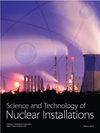具有调节系统响应的TRACE/PARCS耦合CANDU-Shim运行建模与验证
IF 0.9
4区 工程技术
Q3 NUCLEAR SCIENCE & TECHNOLOGY
引用次数: 0
摘要
在CANDU反应堆中,当在线换料能力暂时不可用时,使用垫片操作。通常在堆芯中提供通量平坦化的调节棒,在燃料耗尽时按顺序抽出以提供额外的反应性。在CANDU900反应堆中,八个调节器组中最多有三个可以退出,功率相应降低。在本研究中,使用TRACE_Mac1.1、PARCS_Mac1.1和反应堆调节系统建模脚本的组合对匀场操作进行建模,所有这些都作为单个耦合模拟运行。驱动程序脚本将操作模拟为一系列稳态、耗尽和瞬态模型。将结果与核电站的运行数据进行了比较,评估了关键的优点。通过将功率降低到59%FP并撤回剩余的调节器,将模拟扩展到运行数据之外,以观察模拟反应堆在更深的反应性驱动瞬态中的行为。还评估了敏感情况,包括调整棒耗尽和核数据的不确定性。这项研究成功地再现了垫片操作的一般结果。在垫片的持续时间内,观察到模拟和数据集之间存在一些差异,特别是在垫片的一排输出阶段。发现了早期行为的几个潜在原因。当模拟扩展时,该模型预测,当调节器耗尽时,低于60%FP的功率降低将导致氙中毒,时间对调节器耗尽敏感。PARCS模型的节点化也产生了重大影响,这是由于对调节器节点化的影响及其相对于实际调节器位置的影响区域。核数据的不确定性影响较小,但仍然明显。其他参数,如堆芯中燃料燃耗的分布,对垫片操作的影响很小。本文章由计算机程序翻译,如有差异,请以英文原文为准。
Modelling and Validation of CANDU Shim Operation Using Coupled TRACE/PARCS with Regulating System Response
In CANDU reactors, shim operation is used when the online refuelling capability becomes temporarily unavailable. Adjuster rods, normally in-core to provide flux flattening, are withdrawn in sequence to provide additional reactivity as the fuel is depleted. In a CANDU 900 reactor, up to three of the eight adjuster banks may be withdrawn, with the power derated accordingly. In this study, the shim operation was modelled using a combination of TRACE_Mac1.1, PARCS_Mac1.1, and scripts modelling the reactor regulating system, all running as a single coupled simulation. A driver script simulated the operation as a sequence of steady-state, depletion, and transient models. The results were compared to operational data from a nuclear power plant, evaluating the key figures of merit. The simulation was extended beyond the operational data by reducing the power to 59% FP and withdrawing the remaining adjusters, to observe the behaviour of the simulated reactor for a deeper reactivity-driven transient. Sensitivity cases, including adjuster rod depletion and nuclear data uncertainty, were also evaluated. This study was able to successfully reproduce the general results of the shim operation. Some discrepancies were observed between the simulation and dataset for the duration of the shim, particularly for the one bank out phase of the shim. Several potential causes for the early phase behaviour were identified. When the simulation was extended, the model predicted that a power reduction below 60% FP would lead to xenon poison out when the adjusters were depleted, with the timing sensitive to the adjuster depletion. Nodalisation of the PARCS model also had a significant impact, due to the effect on adjuster nodalisation and its area-of-effect with respect to the actual adjuster locations. Nuclear data uncertainty had a lesser but still noticeable effect. Other parameters, such as the distribution of fuel burnups in the core, only had a small effect on the shim operation.
求助全文
通过发布文献求助,成功后即可免费获取论文全文。
去求助
来源期刊

Science and Technology of Nuclear Installations
NUCLEAR SCIENCE & TECHNOLOGY-
CiteScore
2.30
自引率
9.10%
发文量
51
审稿时长
4-8 weeks
期刊介绍:
Science and Technology of Nuclear Installations is an international scientific journal that aims to make available knowledge on issues related to the nuclear industry and to promote development in the area of nuclear sciences and technologies. The endeavor associated with the establishment and the growth of the journal is expected to lend support to the renaissance of nuclear technology in the world and especially in those countries where nuclear programs have not yet been developed.
 求助内容:
求助内容: 应助结果提醒方式:
应助结果提醒方式:


